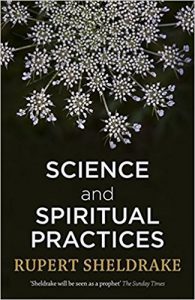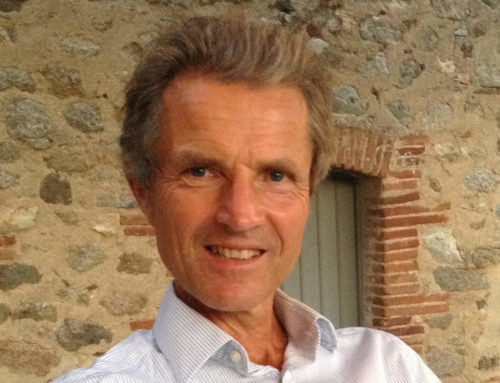Book review by David Lorimer
SCIENCE AND SPIRITUAL PRACTICES
Rupert Sheldrake (Hon SMN)
Coronet, 2017, 247 pp.
ISBN: 978-1-473-63007-9
One of the strategic effects of investment by the John Templeton Foundation has been extensive research into spiritual qualities and their relationship to health and well-being, for instance love, gratitude, forgiveness and altruism. This has helped build the research base behind Rupert’s new book, which is his most personal in relating the contents to his own development. He is a frequent target for militant atheists and materialists, who feel threatened by his open approach and creative experiments. He explains that he himself became an atheist as a teenager and budding scientist, and joined the Cambridge Humanist Association as an undergraduate – he relates an amusing anecdote about Sir Julian Huxley putting himself forward as the ideal sperm donor as a contribution to a more advanced form of humanity.
However, Rupert immediately experienced tension between the mechanistic objectivity of the scientific approach and his own feelings for animals and plants – they were killed in order to be studied, and everything was broken down into reductionist components. As a postgraduate he became a member of a group called the Epiphany Philosophers – ‘an unlikely confluence of quantum physicists, mystics, Buddhists, Quakers, Anglicans and philosophers’ for whom no topic was off-limits. He also spent a year at Harvard studying philosophy and history of science and had a seven-year research fellowship funded by the Royal Society, which gave him the freedom to research what he liked in any part of the world – it also gave him time to think, and is an opportunity analogous to a Fellowship at All Souls College, Oxford. This led him to Malaysia and subsequently to India and Sri Lanka where he discovered totally different ways of looking at the world. He learned TM in Cambridge in 1971 and worked in India from 1974, writing his first book at Bede Griffiths’ ashram – Father Bede was a huge influence in the way he bridged East and West, as well as opening him up Christian mysticism. Later in the book, one also learns about the influence of his herbalist and pharmacist father and the experience of time spent in gardens.
The book discusses seven spiritual practices in which Rupert himself participates. These are meditation and the nature of minds, the flow of gratitude, reconnecting with the more than human world, relating to plants, rituals and the presence of the past, singing, chanting and the power of music, and pilgrimages and holy places. In each case, Rupert describes some of his own experience, the research behind it and offers a couple of practices for readers at the end of each chapter. These are all simple activities that anyone can incorporate in their daily lives.
In the meditation chapter, it is interesting to learn that some atheists like Sam Harris are also meditation teachers – they recognise the beneficial effects even without subscribing to the underlying philosophy. This raises an interesting point of interpretation, as many practitioners would feel that they are a microcosm of a more universal mind, to which they are relating during meditation or indeed prayer. Meditation is also a good example of spirituality developing outside formal religion. Rupert covers the recent history, including work of Herbert Benson on the relaxation response and Jon Kabat-Zinn on mindfulness. An attitude of gratitude is something we can all practise, and there is extensive evidence for its beneficial effects on well-being, happiness and health. In this respect, Rupert points out that Christians have more reason to be grateful simply because of the way they understand the relationship between life and God.
Some clinicians are now prescribing Nature in terms of walks and woods, and here we can perhaps reconnect with our own childhood experience, in my case climbing and sitting in trees; sadly, the time children spend in Nature is declining. Rupert explains the deeper roots of the split from Nature and God with the decline of animism – the Celtic tradition was particularly rich with such figures as St Cuthbert of Lindisfarne. Protestantism paves the way for mechanistic science through a disenchanted attitude and the banning of pilgrimages, because they are not mentioned in the Bible. On the other hand, there was the influence of Romanticism and transcendentalism – Rupert nicely sums this up in a table summarising worldview, God, nature and evolution (p. 82). He also sees a recent revival of animism and panpsychism, and speculates about the sense in which the sun might be conscious.
He continues the theme of Nature with a chapter on plants, flowers and beauty, moving on to the significance of sacred groves and the relationship between tree trunks and the design of cathedral pillars. Thoreau and John Muir were pioneers in this respect, the latter referring to Yosemite as a natural cathedral – here Rupert encourages us to take a bee’s eye view of plants and to get to know a particular tree in our locality (another nice suggestion is finding a ‘sit spot’). In the next chapter, he shows how rituals can connect us to the past through acts of remembrance, initiations and rites of passage – he links these with morphic resonance. He makes an intriguing connection between ritual drowning in full immersion baptism and the experience of NDEs, and also explains the background of sacrifice in Judaism and Christianity while pointing out that modern science sacrifices animals on an industrial scale in its experiments.
The chapter on singing, chanting and the power of music enables him to bring in the work of his wife Jill Purce as well as mantras, social entrainment and the effects of singing together. When allied to dance, this has been regarded with suspicion by religious authorities who impose certain restrictions. It is also worth mentioning his championing of Choral Evensong as a contemplative practice – see www.choralevensong.org. In recent years, there has been a tremendous revival of interest in pilgrimage, and Rupert is a patron of the British Pilgrimage Trust. This gives people a direct experience of life as a journey, providing space for reflection in our overloaded world. He suggests that we can turn our journeys into pilgrimages, especially when visiting cathedrals, and I have on a number of occasions lit candles with him in such places.
In his conclusions where he describes the rise of modern secularism, he points out that the materialist worldview is in fact a belief system, not a statement of scientific facts as many believe – a case he made extensively in his previous book The Science Delusion. Religions are about consciousness and ‘founded on the assumption that consciousness transcends the human level’ – this is precisely a problematic area for scientific materialism. Rupert makes the interesting point that in giving up our ancestral religion, we are also giving up ‘singing and chanting together, praying, participating in traditional rituals and festivals, and saying grace before meals.’ (p. 201) The findings he discusses indicate that spiritual practices make people happier, healthier and less depressed, which is not surprising when one thinks of such practices as different forms of connection that are also nourishing and give us a sense of meaning. This is both a hopeful and helpful message from this lucid and important book that helps bridge science and spirituality for our time – and we can look forward with anticipation to the second volume.
Buy Science and Spiritual Practices here.
